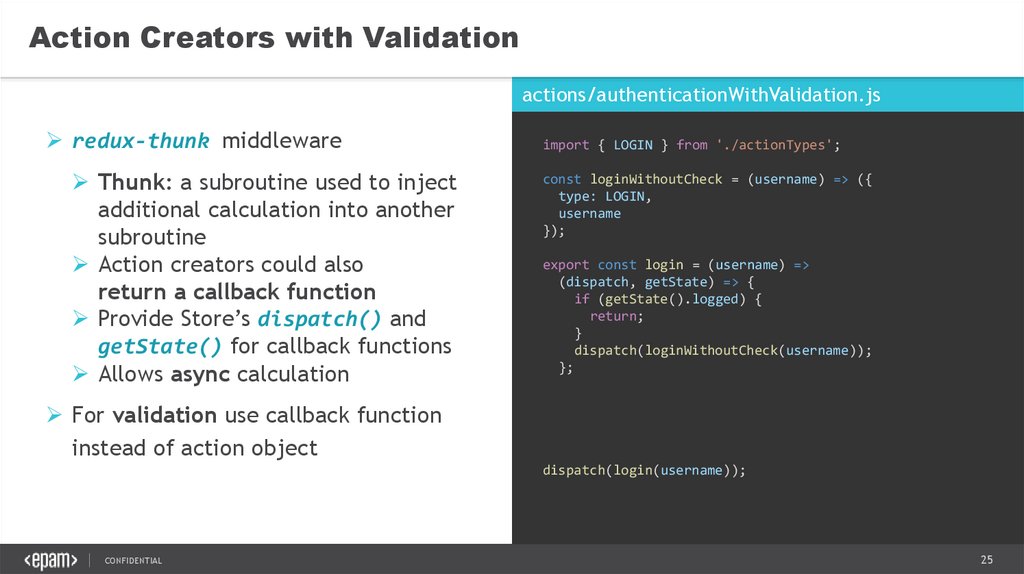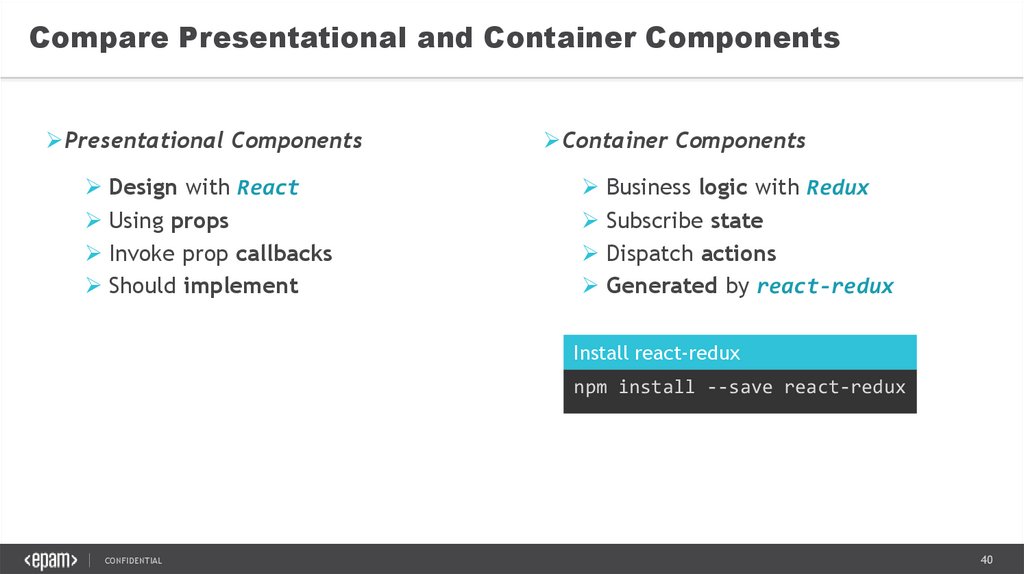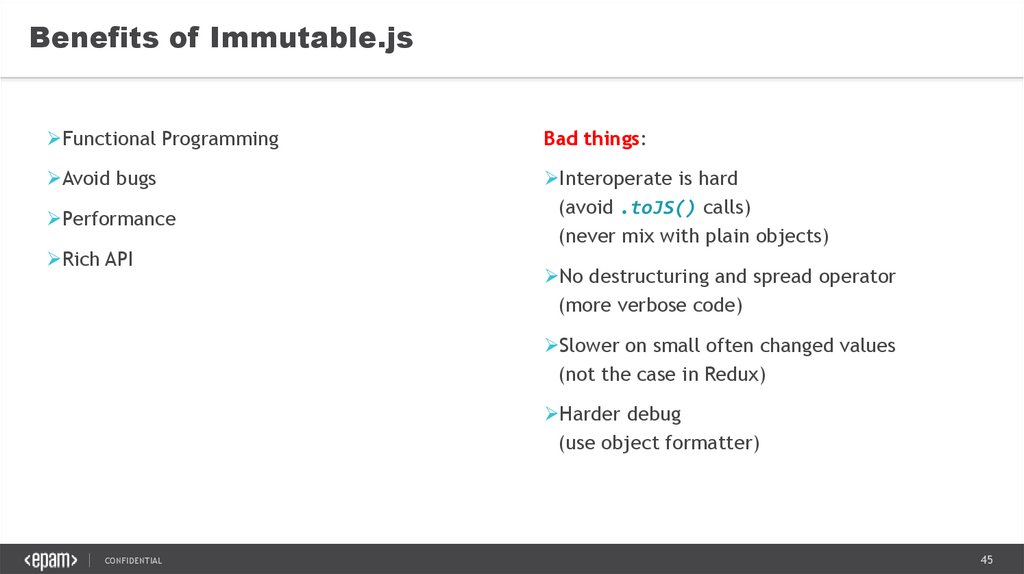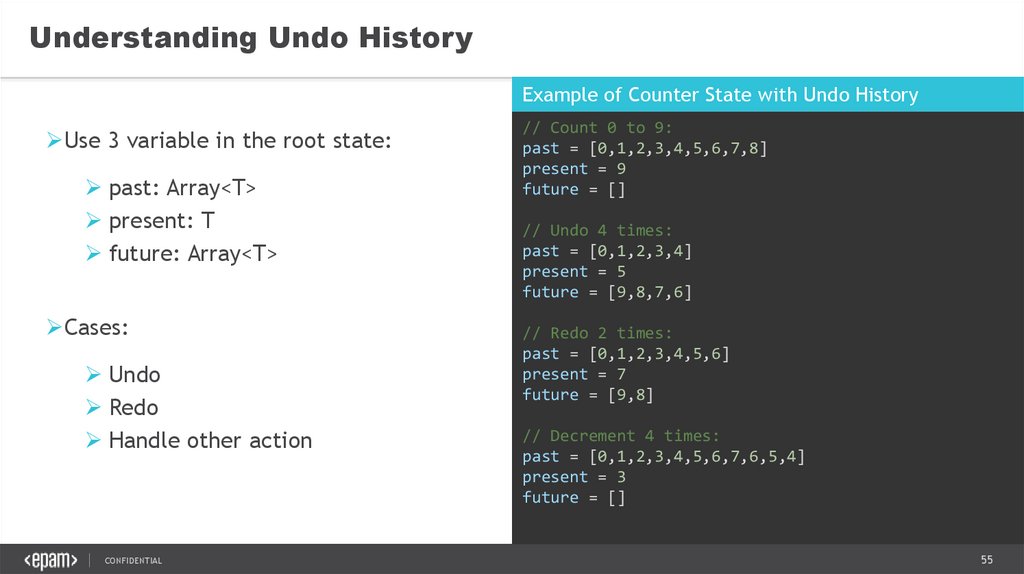Similar presentations:
Redux
1.
REDUXZsolt German
zsolt_german@epam.com
MARCH 14, 2018
CONFIDENTIAL
1
2.
AgendaAbout
Basics
Best Practices
Usage with React
Advanced technics
CONFIDENTIAL
2
3. About Flux and Redux
ReduxABOUT FLUX
AND REDUX
CONFIDENTIAL
3
4.
FLUXUI views
Application architecture
can be more
Pattern
By Facebook
Event (onClick)
user interaction
update state
(new state)
Replace MVC model
Flux
Predictable data
Unidirectional data flow
data flow
Stores
can be more
Action
(from method
parameters)
Complements React UI
dispatch Action
(edit post, add
new comment)
CONFIDENTIAL
Action
Creator
Dispatcher
4
5.
ReduxUI view
State management library
Inspired by Flux
update state
(new state)
Tiny library
Small dependency
(just using a polyfill)
Redux
data flow
Use with React, Angular, etc.
Centralized Store
event (onClick)
user interaction
Action
Creator
Store
calculate
new state
holds current
state
dispatch action
(edit post, add
new comment)
Reducer
pure function
CONFIDENTIAL
5
6.
Three Principles• Store saves a single state tree
1
Single
source of truth
• Easy debug and inspection
• Undo/redo became trivial
• Actions describe what happened
2
State is
read-only
• Changes are centralized
• Easy log, serialize, replay
3
Changes made
with pure
functions
CONFIDENTIAL
• Reducer transforms the state tree
• New state, no mutation
• Code splitting, reusability
6
7. Basics
ReduxBASICS
CONFIDENTIAL
7
8.
ReduxCONFIDENTIAL
8
9.
Install and Import ReduxInstall Redux as development
dependency
Install Redux with npm
Import functions where you use them
Import Redux in code
npm install --save redux
import { createStore } from 'redux';
CONFIDENTIAL
9
10.
Design State ShapeState examples
All app state
Single object
Keep minimal
Store provide
CONFIDENTIAL
// Example when user logged out
{
logged: false,
username: ''
}
// Example when user logged in
{
logged: true,
username: 'username'
}
10
11.
Store./index.js
Holds app state
createStore(): init Store
import { createStore } from 'redux';
import reducer from './reducers/authentication';
// Create store
export const store = createStore(reducer);
.getState(): get state
.dispatch(): “update” state
.subscribe(): register listener
Unregister listener via callback
(that .subscribe() returned)
// Subscribe state changes
const unreg = store.subscribe(() => {
// Get actual state
console.log(store.getState())
});
// Dispatch actions
store.dispatch({ type: 'LOGIN', username: 'username' });
store.dispatch({ type: 'LOGOUT' });
// Unsubscribe listener
unreg();
CONFIDENTIAL
11
12.
ActionsAction examples
Plain objects
Payloads of information
// Example when user logs in
{
type: 'LOGIN',
username: 'username'
}
// Example when user logs out
{
type: 'LOGOUT'
}
CONFIDENTIAL
12
13.
Reducers./reducers/authentication.js
Specify state change
Pure function:
No mutation
No side effect
Returns new state object
Default returns previous state
const initState = { logged: false, username: '' };
const auth = (state = initState, action) => {
switch (action.type) {
case 'LOGIN':
return Object.assign({}, state, {
logged: true,
username: action.username
});
case 'LOGOUT':
return Object.assign({}, state, {
logged: false,
username: ''
});
default:
return state;
}
};
export default auth;
CONFIDENTIAL
13
14. Best Practices
ReduxBEST PRACTICES
CONFIDENTIAL
14
15. Action Creators
ReduxACTION CREATORS
CONFIDENTIAL
15
16.
Action Types and Action Creatorsactions/actionTypes.js
Keep all action types in a separate file
All existing actions in one place
Create action creators
More verbose code
// Authentication
export const LOGIN = 'LOGIN';
export const LOGOUT = 'LOGOUT';
// User management
export const USER_ADD = 'USER_ADD';
export const USER_DELETE = 'USER_DELETE';
actions/authentication.js
import { LOGIN, LOGOUT } from './actionTypes';
export const login = (username) => ({
type: LOGIN,
username
});
export const logout = () => ({
type: LOGOUT
});
CONFIDENTIAL
16
17.
Generate Action Creatoractions/todo.js with action creator factory
You can generate action creators with
factories
You can use libraries for that like
redux-act or redux-actions
function makeActionCreator(type, ...argNames) {
return function (...args) {
let action = { type };
argNames.forEach((arg, index) => {
action[argNames[index]] = args[index];
})
return action;
}
}
export const addTodo =
makeActionCreator(ADD_TODO, 'text');
export const editTodo =
makeActionCreator(EDIT_TODO, 'id', 'text');
export const toggleTodo =
makeActionCreator(TOGGLE_TODO, 'id');
export const removeTodo =
makeActionCreator(REMOVE_TODO, 'id');
CONFIDENTIAL
17
18. Reducers
ReduxREDUCERS
CONFIDENTIAL
18
19.
Reducer CompositionApp
App state has hierarchy
(properties of properties)
Reducer
composition
Write reducers on part of the states
(reducer state != app state)
Combine them
(down to up)
Notifications
Users
Articles
Reducer
composition
Liked Articles
CONFIDENTIAL
Roles
Comments
19
20.
Splitting Reducersreducers/notifications.js
When fields are independent
Reducer composition with:
combineReducers()
Reducers could split into files
export const notifications = (state = 0, action) => {
switch (action.type) {
case SET_NOTIFICATIONS:
return action.notifications;
default:
return state;
}
};
state is not the app state!
reducer.js
import notifications from 'reducers/notifications.js';
import users from 'reducers/users.js';
import articlesReducer from 'reducers/articlesReducer.js';
export const reducer = combineReducers({
notifications,
users,
articles: articlesReducer
});
CONFIDENTIAL
20
21. Middleware
ReduxMIDDLEWARE
CONFIDENTIAL
21
22.
MiddlewareThere can be several middleware entities, each performing its own useful role in
an Application
Middleware is a curried function which receives current store, next middleware in
the chain, and current action
They are connected during the creation of store:
const logMiddleware = store => next => action => {
console.log(action);
next(action);
};
CONFIDENTIAL
22
23.
Redux Thunkconst INCREMENT_COUNTER = 'INCREMENT_COUNTER';
function increment() {
return {
type: INCREMENT_COUNTER
};
}
function incrementAsync() {
return dispatch => {
setTimeout(() => {
// Yay! Can invoke sync or async actions with `dispatch`
dispatch(increment());
}, 1000);
};
}
CONFIDENTIAL
23
24.
Using Middleware./middleware/logger.js
3rd party extension point
export default store => next => action => {
console.log('dispatching', action);
let result = next(action);
console.log('next state', store.getState());
Between action and reducer
For logging, routing, etc.
return result;
}
Async middleware, e.g.: redux-thunk
./index.js
import
import
import
import
{ createStore, applyMiddleware } from 'redux';
thunk from 'redux-thunk';
logger from './middleware/logger.js';
appReducer from './appReducer';
let store = createStore(
appReducer,
applyMiddleware(logger, thunk)
);
CONFIDENTIAL
24
25.
Action Creators with Validationactions/authenticationWithValidation.js
redux-thunk middleware
Thunk: a subroutine used to inject
additional calculation into another
subroutine
Action creators could also
return a callback function
Provide Store’s dispatch() and
getState() for callback functions
Allows async calculation
import { LOGIN } from './actionTypes';
const loginWithoutCheck = (username) => ({
type: LOGIN,
username
});
export const login = (username) =>
(dispatch, getState) => {
if (getState().logged) {
return;
}
dispatch(loginWithoutCheck(username));
};
For validation use callback function
instead of action object
dispatch(login(username));
CONFIDENTIAL
25
26. Summary
ReduxSUMMARY
CONFIDENTIAL
26
27.
Summary of Data Flow with Best Practices1
2
3
4
You
Store
Root reducer
Store
dispatch
reducer
output tree
whole state
• Create Action via
Action Creator
• In: Previous state
and Action
• combineReducers()
• Listeners invoked
• Action describes
what happened
• Out: Next state
call
CONFIDENTIAL
calls
combines
saves
• Bind to UI (later):
react-redux
27
28. Usage with React
ReduxUSAGE WITH REACT
CONFIDENTIAL
28
29. Design
ReduxDESIGN
CONFIDENTIAL
29
30.
Interworking between React and Reduxprovide state (to props)
and callbacks (for events)
UI view
Split UI view: logic and rendering
Container Component
Container
Component
Presentational
Component
Redux
React
Provide state parts via props
Dispatch events via callbacks
update state
(new state)
Presentational Component
Using props to
observe state changes
Invoke callbacks on events
Redux
data flow
Store
calculate
new state
holds current
state
dispatch action
(edit post, add
new comment)
event (onClick)
user interaction
Action
Creator
Reducer
pure function
CONFIDENTIAL
30
31.
Application for designAuthBox(AuthInput)
AuthDisplayer(AuthInfo)
LogoutButton
CONFIDENTIAL
31
32. Basic components
ReduxBASIC COMPONENTS
CONFIDENTIAL
32
33.
Presentational Componentscomponents/AuthInfo.js
Redux not used here
Properties provided by
its container component
from state
import React from 'react';
export const AuthInfo =
({ logged, username }) => (
<h1>
Current state is {
'logged ' + (logged
? `in as '${username}'`
: 'out')
}
</h1>
);
export default AuthInfo;
CONFIDENTIAL
33
34.
Container Componentscontainers/AuthDisplayer.js
React not used here
These are just data providing
No visual elements
Use them in the App.js (later)
CONFIDENTIAL
import { connect } from 'react-redux';
import AuthInfo from '../components/AuthInfo';
const mapStateToProps = state => ({
logged: state.logged,
username: state.username
});
const AuthDisplayer =
connect(mapStateToProps)(AuthInfo);
export default AuthDisplayer;
34
35.
Presentational Components with Local Statecomponents/AuthInput.js
Presentational components could have
local state
export class AuthInput extends Component {
constructor(props) {
super(props);
this.state = { username: '' };
}
handleChange = (event) => {
this.setState({ [event.target.name]: event.target.value }); }
loginClick = () => {
this.props.handleLogin(this.state.username); }
logoutClick = () => {
this.props.handleLogout();
this.setState({ username: '' });
}
render = () => {
const btnLabel = this.props.logged ? 'logout' : 'login';
const btnClick = this.props.logged
? this.logoutClick : this.loginClick;
return (
<div>
<input type="text" name="username" disabled={this.props.logged}
onChange={this.handleChange} value={this.state.username} />
<button type="button" onClick={btnClick}>{btnLabel}</button>
</div>
) } }
export default AuthInput;
CONFIDENTIAL
35
36.
Container Components with Callbackscontainers/AuthBox.js
Here we provided callbacks
import { connect } from 'react-redux';
import { LOGIN, LOGOUT } from '../actions/actionTypes';
import AuthInput from '../components/AuthInput';
const mapStateToProps = (state, ownProps) => ({
logged: state.logged
});
const mapDispatchToProps = (dispatch, ownProps) => ({
handleLogin: (username) => {
dispatch({ type: LOGIN, username });
},
handleLogout: () => {
dispatch({ type: LOGOUT });
}
});
export const AuthBox = connect(
mapStateToProps, mapDispatchToProps
)(AuthInput);
export default AuthBox;
CONFIDENTIAL
36
37. Mixed components
ReduxMIXED COMPONENTS
CONFIDENTIAL
37
38.
Presentational Container Componentscontainers/LogoutButton.js
Use React and Redux also
Got dispatch in props
connect provides to the
presentational component part
Presentational Component part
Use only when logic is small
Split as component grows
Container Component part
CONFIDENTIAL
import React from 'react';
import { connect } from 'react-redux';
import { LOGOUT } from '../actions/actionTypes';
const LogoutButtonLayout = ({dispatch, logged}) => {
if (!logged) {
return false;
}
const handleLogout = () => {
dispatch({ type: LOGOUT });
}
return (
<button type="button"
onClick={handleLogout}>Logout</button>
)
}
const mapStateToProps =
state => ({ logged: state.logged });
export const LogoutButton =
connect(mapStateToProps)(LogoutButtonLayout)
export default LogoutButton;
38
39. Summary of components
ReduxSUMMARY OF COMPONENTS
CONFIDENTIAL
39
40.
Compare Presentational and Container ComponentsPresentational Components
Design with React
Using props
Invoke prop callbacks
Should implement
Container Components
Business logic with Redux
Subscribe state
Dispatch actions
Generated by react-redux
Install react-redux
npm install --save react-redux
CONFIDENTIAL
40
41. Connect Redux and React
ReduxCONNECT REDUX AND REACT
CONFIDENTIAL
41
42.
Passing the Storecomponents/App.js
Create the App component
Use Provider from react-redux
export const App = () => (
<div>
<AuthBox />
<AuthDisplayer />
<LogoutButton />
</div>
);
export default App;
index.js
import React from 'react';
import ReactDOM from 'react-dom';
import { createStore } from 'redux';
import { Provider } from 'react-redux';
import auth from './reducers/auth';
import App from './components/App';
const store = createStore(auth);
ReactDOM.render(
<Provider store={store}>
<App />
</Provider>,
document.getElementById('root')
);
CONFIDENTIAL
42
43. Advanced Technics
ReduxADVANCED TECHNICS
CONFIDENTIAL
43
44. Immutable.js
ReduxIMMUTABLE.JS
CONFIDENTIAL
44
45.
Benefits of Immutable.jsFunctional Programming
Bad things:
Avoid bugs
Interoperate is hard
(avoid .toJS() calls)
(never mix with plain objects)
Performance
Rich API
No destructuring and spread operator
(more verbose code)
Slower on small often changed values
(not the case in Redux)
Harder debug
(use object formatter)
CONFIDENTIAL
45
46. Async Data flow
ReduxASYNC DATA FLOW
CONFIDENTIAL
46
47.
Async Data FlowActions:
POSTS_FETCH_REQUEST:
isFetching: true
Fetch failure
Fetch request
No Data
Fetching
Error
isFetching: true
POSTS_FETCH_SUCCESS:
isFetching: false
didInvalidate: false
lastUpdated: Date.now()
POSTS_FETCH_FAILURE:
Handle error
POSTS_INVALIDATE:
didInvalidate: true
CONFIDENTIAL
Fetch request
Fetch success
Async
data
Invalidated
flow
Fetch request Has Data
isFetching: false
didInvalidate: false
lastUpdated: Date.now()
didInvalidate: true
Invalidate
47
48.
Async State ShapeExample of Async State Shape
Some state variable needed for store
async process status:
{
selectedUser: user1',
posts: {
12: { id: 12, post: '...' }
},
postsByUsers: {
'user1': {
items: [12],
isFetching: false,
didInvalidate: false,
lastUpdated: 1439478405547
}
}
isFetching: the fetch has begun
didInvalidate: refresh needed
lastUpdated: last fetch time
These should be handled in the reducer.
}
CONFIDENTIAL
48
49.
Fetch in ReduxFetch in Redux
Create action creators
(same as before)
Create reducer (same as before)
Create thunk that use action creators
(“async action creator”)
Dispatch with the thunk
This code always fetches
Create another thunk that use
fetchPosts() when needed
CONFIDENTIAL
const requestPosts = (user) => ({
type: REQUEST_POSTS,
user
});
const receivePosts = (user, json) => ({
type: RECEIVE_POSTS,
user,
posts: json.data.children.map(child => child.data),
receivedAt: Date.now()
});
export const invalidateSubreddit = (user) => ({
type: INVALIDATE_POSTS,
user
});
const fetchPosts = user => dispatch => {
dispatch(requestPosts(user));
return fetch(`https://www.reddit.com/r/${user}.json`)
.then(response => response.json())
.then(json => dispatch(receivePosts(user, json)))
};
// store.dispatch(fetchPosts('reactjs'))
//
.then(() => console.log(store.getState()));
49
50.
Fetch with ChecksAsync Actions
Create a function for the condition
Create the new thunk that invoke
the previous thunk when condition true
Dispatch is the same
Use the thunk in the UI
as used action creators before
const shouldFetchPosts = (state, user) => {
const posts = state.postsByUser[user];
if (!posts) {
return true;
} else if (posts.isFetching) {
return false;
} else {
return posts.didInvalidate;
}
};
const fetchPostsIfNeeded = user => (dispatch, getState) => {
if (shouldFetchPosts(getState(), user)) {
return dispatch(fetchPosts(user));
} else {
return Promise.resolve();
}
};
// store.dispatch(fetchPostsIfNeeded('reactjs'))
//
.then(() => console.log(store.getState()));
CONFIDENTIAL
50
51. Reselect
ReduxRESELECT
CONFIDENTIAL
51
52.
Computing Derived Datacontainers/VisibleTodoList.js
Render todos with filter
import { connect } from 'react-redux';
import TodoList from '../components/TodoList';
Re-render without change:
const getVisibleTodos = (todos, filter) => {
switch (filter) {
case 'SHOW_ALL':
return todos;
case 'SHOW_COMPLETED':
return todos.filter(t => t.completed);
case 'SHOW_ACTIVE':
return todos.filter(t => !t.completed);
}
}
every time todos are same value,
but different reference
It makes change detection inefficient
Performance issue because rendering
Solve this with reselect library
CONFIDENTIAL
const mapStateToProps = state => ({
todos: getVisibleTodos(state.todos, state.filter)
});
export const VisibleTodoList = connect(
mapStateToProps
)(TodoList);
52
53.
Efficiently Compute Derived Data with reselect Librarycontainers/VisibleTodoList.js
createSelector():
creates memorized selector
When
Could split to:
selectors/*.js
related state values are same
(via input-selectors)
then result is the same
(via transform function)
Problem: couldn’t reuse the selector
Solution: Make factories for
selector and mapStateToProps
CONFIDENTIAL
import { createSelector } from 'reselect’;
const getFilter = state => state.filter;
const getTodos = state => state.todos;
export const getVisibleTodos = createSelector(
[getFilter, getTodos],
(filter, todos) => {
switch (filter) {
case 'SHOW_ALL':
return todos;
case 'SHOW_COMPLETED':
return todos.filter(t => t.completed);
case 'SHOW_ACTIVE':
return todos.filter(t => !t.completed);
}
}
);
const mapStateToProps = state => ({
todos: getVisibleTodos(state)});
export const VisibleTodoList = connect(
mapStateToProps)(TodoList);
53
54. Redux Undo
ReduxREDUX UNDO
CONFIDENTIAL
54
55.
Understanding Undo HistoryExample of Counter State with Undo History
Use 3 variable in the root state:
past: Array<T>
present: T
future: Array<T>
Cases:
Undo
Redo
Handle other action
CONFIDENTIAL
// Count 0 to 9:
past = [0,1,2,3,4,5,6,7,8]
present = 9
future = []
// Undo 4 times:
past = [0,1,2,3,4]
present = 5
future = [9,8,7,6]
// Redo 2 times:
past = [0,1,2,3,4,5,6]
present = 7
future = [9,8]
// Decrement 4 times:
past = [0,1,2,3,4,5,6,7,6,5,4]
present = 3
future = []
55
56.
Undo History with redux-undoInstall redux-undo
Use redux-undo library
distinctState(): ignore actions that
didn’t result state change
Dispatch actions with
ActionCreators.undo(),
ActionCreators.redo(), etc.
npm install --save redux-undo
reducers/undoableTodos.js
import undoable from 'redux-undo';
import todos from '../reducers/todos';
export const undoableTodos = undoable(
todos, { filter: distinctState() }
);
index.js
import { ActionCreators } from 'redux-undo';
store.dispatch(ActionCreators.undo());
store.dispatch(ActionCreators.redo());
store.dispatch(ActionCreators.jump(-2));
store.dispatch(ActionCreators.jump(5));
store.dispatch(ActionCreators.clearHistory());
CONFIDENTIAL
56
57. React Router
ReduxREACT ROUTER
CONFIDENTIAL
57
58.
React RouterRedux and React Router
Redux:
source of truth of data
React Router:
source of truth of url
Cannot change URL in actions
Cannot time travel
Cannot rewind action
// Connect React Router with Redux App:
const Root = ({ store }) => (
<Provider store={store}>
<Router>
<Route path="/:filter?" component={App} />
</Router>
</Provider>);
// Navigating with React Router:
const Links = () => (<div>
<Link to="/">Show All</Link>
<Link to="/SHOW_ACTIVE">Show Active</Link>
<Link to="/SHOW_COMPLETED">Show Completed</Link>
</div>);
// App gets the matched URL parameters,
// and provide components to their props
const App = ({ match: { params } }) => (<div>
<VisibleTodoList filter={params.filter || 'SHOW_ALL'} />
<Links />
</div>);
// In container components you could use
// the matched parameter from ownProps
const mapStateToProps = (state, ownProps) => ({
todos: getVisibleTodos(state.todos, ownProps.filter)
});
CONFIDENTIAL
58
59. Sub-App approach
ReduxSUB-APP APPROACH
CONFIDENTIAL
59
60.
Isolating SubAppssubapps/SubApp.js
Independent SubApps
Won’t share data
Won’t share actions
Won’t communicate each other
Useful for large teams
Each component have own store
import subAppReducer from './subAppReducer.js';
export class SubApp extends Component {
constructor(props) {
super(props);
this.store = createStore(subAppReducer);
}
render = () => (
<Provider store={this.store}>
<App />
</Provider>
)
}
app.js
import SubApp from './subapps/SubApp.js';
export const BigApp = () => (<div>
<SubApp />
<OtherSubApp2 />
<OtherSubApp3 />
</div>);
CONFIDENTIAL
60
61. Questions?
ReduxQUESTIONS?
CONFIDENTIAL
61
62. Resources
ReduxRESOURCES
CONFIDENTIAL
62
63. Thanks for your attention!
ReduxTHANKS FOR YOUR ATTENTION!
CONFIDENTIAL
63































































 programming
programming








